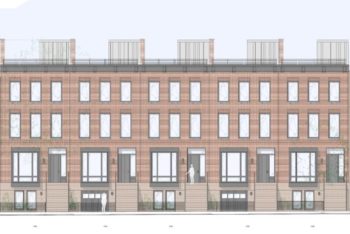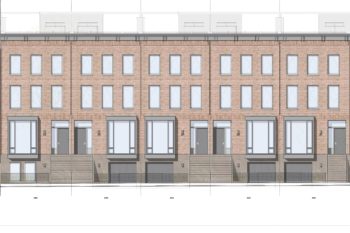
Rendering of Approved 352-360 Clermont Ave. Image Credit: Landmarks and CWB Architects
New rowhouses in Fort Greene will feature curb cuts and garages. On September 10, 2019, the Landmarks Preservation Commission considered and voted to approve a Certificate of Appropriateness to construct five new four-story rowhouses at 352-360 Clermont Avenue in the Fort Greene Historic District in Brooklyn. The site is currently used as a one story garage and parking lot. Brendan Coburn of CWB Architects presented on behalf of the applicant.
The Fort Greene Historic District is centered around Fort Greene Park, the site of the 1776 Battle of Long Island. The district reflects the architectural development of Brooklyn’s middle-class residential neighborhoods and retains much of its original 19th century ambiance. Much of Fort Greene is reflected in two or three-story brick rowhouses with stone trimming. Fort Greene is home to other architectural feats including the Brooklyn Masonic Temple, built in 1909, the Brooklyn Academy of Music, the oldest performing arts venue in America, and Queen of All Saints Church, built in Gothic revival style.
The five proposed rowhouses will be four-stories tall with a base height of thirty-nine feet with a three-foot six-inch parapet. The architect purports the design to be a modern take on a traditional brownstone. Two of the five rowhouses feature basement level garages, driveways and two separate curb cuts. Each rowhouse features six aluminum-clad tilt/turn wood windows on the top two floors and a front oriel bay window. Two 4-story row houses border the lot on either side.
The design originally presented on April 30, 2019, featured five new four-story rowhouses with a base height of forty feet and a three-foot six-inch parapet. The plan included two ten foot curb cuts, creating two separate shared driveways. The first curb cut led to the driveway belonging to 358 Clermont Ave and 356 Clermont Ave. The second ten foot curb cut led to the driveway belonging to 354 Clermont Ave and 352 Clermont Ave. While the driveways were shared, each residence had their own basement-level garage. In order to accommodate the shared driveways, the architect designed a shared stoop for 360 Clermont Ave and 358 Clermont Ave and a shared a stoop for 356 Claremont Ave and 354 Claremont Ave. The parlor floor included a prominent oriel bay window, facing Clermont Avenue and the Bishop Loughlin Memorial High School yard. The façade featured an Irish gold modular brick, aluminum-clad tilt-turn windows, and black steel trimmings on the oriel bay window, roof base and roof guard rails. The garage was set to be painted black wood.

First Rendering of 352-360 Clermont Ave Image Credit: Landmarks and CWB Architects
The applicant’s September 10, 2019, presentation addressed the Commission’s April 30th concerns. A large portion of the Commission took issue with initial size of the oriel bay window, stating it was larger than normally featured on traditional Fort Greene rowhouses. The bay window size predominated much of the discussion on April 30, 2019. The oriel bay windows were made visibly smaller on the approved design.
At the first hearing, the Commission had significant discussion about the existence of garages and curb cuts in traditional rowhouses. The commission agreed that basement level garages are uncommon. The initially proposed double garages per two curb cuts were both reduced in number and size. The final design features only two garages. The existence of only two garages enabled the architect to half the length of the curb cuts.
The rest of the design changes are intended to help the project aesthetically conform to the rowhouses on Clermont Ave and to the greater Fort Greene Historic District. The two shared-stoops were subsequently detached. This resulted in each residence having their own stoop, as traditionally found on rowhouses. The architect also lowered the building height by one foot, to better match the height of the neighboring rowhouses. Additional brickwork was mixed in to enhance the articulation of the façade.
Upon approval, the Commission noted that the garages will not add to the historic nature of the district nor are they in character with the district. But nonetheless, building rowhouses where a garage and parking lot once stood, will add value to the district.
By: Jason Rogovich (Jason Rogovich is the CityLaw Fellow and New York Law School Graduate, Class of 2019)


Shared driveways can be a nightmare and a constant source of arguments.